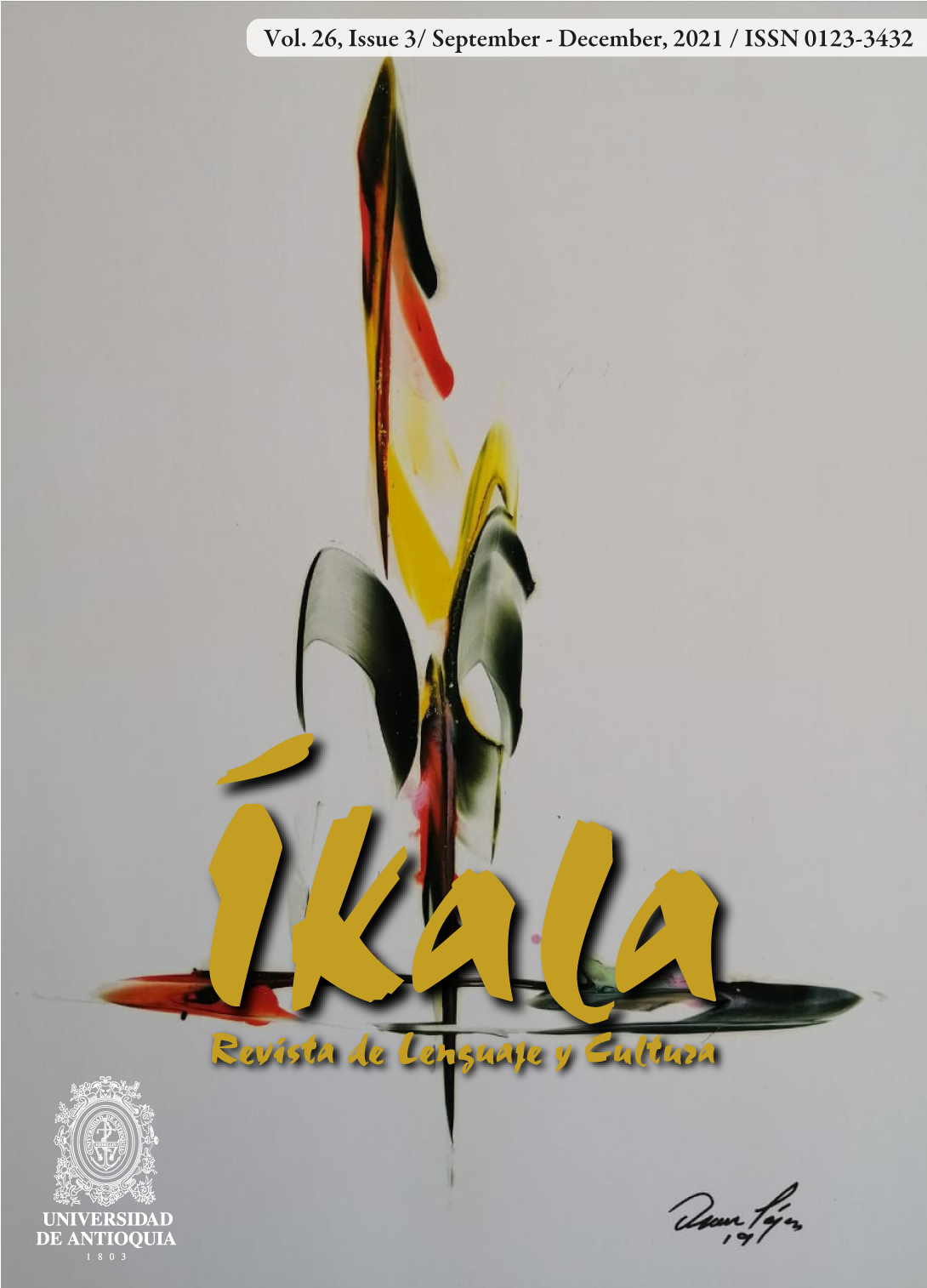Teaching English Online During the National Lockdown: Students’ Perceptions and Experiences at a Spanish University
DOI:
https://doi.org/10.17533/udea.ikala.v26n3a08Schlagworte:
covid-19, second-language acquisition, English teaching, online teachinglearning strategies, information and communication technologiesAbstract
The outbreak of the covid-19 pandemic in Spain was a major challenge for universities offering face-to-face education since these were compelled to adjust to online teaching in an extremely brief time span. This article aims to offer a comprehensive picture of the repercussions that such a sudden immersion in full virtual mode had on instrumental English subjects taught in different undergraduate programs at Universidad de Alcalá in Spain. The profile is based on the data collected from: (a) a survey with 159 respondents enrolled in English courses in the faculties of Philosophy and Arts, and of Economics, Business and Tourism; and (b) a subsequent discussion group, including the authors of the study and a deliberately selected number of respondents. Both methods were used to delve into core aspects of language teaching such as: (a) skills acquisition, (b) assessment methods, (c) the usefulness of the ict tools employed in the classroom, or in-class, and (d) interactions between students and between students and teachers in this exceptional context of unforeseen remote education. Results underscore the problems this scenario entails for the practice and acquisition of skills such as oral performance, class participation, or the management of teamwork and interpersonal relationships. They also pinpoint certain benefits related to an enhanced knowledge and handling of ict tools. Finally, they give instructors insight into the digital applications and assessment instruments which were more and less highly valued by students.
Downloads
Literaturhinweise
Al-Mahrooqi, R. y Troudi, S. (2014). Using technology in foreign language teaching. Cambridge Scholars Publishing.
Almazán-Gómez, A. (2020). COVID-19: ¿punto sin retorno de la digitalización de la educación? Revista Internacional de Educación para la Justicia Social, 9(3), 1-4. https://revistas.uam.es/riejs/article/view/12089/12009
Blessinger, P. y Wankel, C. (2013). Novel approaches in higher education: An introduction to web 2.0 and blended learning technologies. En C. Wankel y P. Blessinger (Eds.), Increasing students’ engagement and retention in e-learning environments: Web 2.0 and blended learning technologies (pp. 3-16). Emerald.
Cacheiro González, M. L. (2018). Educación y tecnología: estrategias didácticas para la integración de las TIC. UNED Publicaciones.
Cenich, G. y Santos, G. (2005). Propuesta de aprendizaje basado en proyecto y trabajo colaborativo: experiencia de un curso en línea. Revista Electrónica de Investigación Educativa, 7(2), 1-18. https://redie.uabc.mx/redie/article/view/133
Cobo, C. (2019). Acepto las condiciones. Usos y abusos de las tecnologías digitales. Santillana.
Dey, B. y Ali, F. (2016). A critical review of the ict for development research. En B. Dey, K. Sorour y R. Filieri (Eds.), ICTs in developing countries (pp. 7-23). Palgrave Macmillan.
Durán Medina, J. F., Godoy Martín, F. J. y Martínez Terceño, J. (2018). Las TIC en las aulas de enseñanza superior. Gedisa.
España, Ministerio de Universidades (2020). Datos y cifras del sistema universitario español. https://www.educacionyfp.gob.es/dam/jcr:b9e82c7a-1174-45ab-8191-c8b7e626f5aa/informe-datos-y-cifras-del-sistema-universitario-espa-ol-2019-2020-corregido.pdf
Jandrić, P. (2020). Postdigital research in the time of COVID-19. Postdigital Science and Education, 2, 233-238. https://doi.org/10.1007/s42438-020-00113-8
Loveless, A. (2003). The role of ICT. Continuum.
Macaro, E. (2003). Teaching and learning a second language. A guide to recent research and its application. Continuum.
Marczak, M. (2013). Communication and information technology in (intercultural) language teaching. Cambridge Scholars Publishing.
McLaren, P., Wang, Y. y Jandrić, P. (2020). Reflections I and II: Reflections from education and the arts in the COVID-19 era. Communiars. Revista de Imagen, Artes y Educación Crítica y Social, (4), 10-13. https://revistascientificas.us.es/index.php/Communiars/article/view/12779
O’Dowd, R. y Dooly, M. (2020). Intercultural communicative competence development through telecollaboration and virtual exchange. En J. Jane (Ed.), The Routledge handbook of language and intercultural communication (pp. 361-375). Routledge.
Ramón-Ruiz, G. (2020). Marcas de la pandemia: el derecho a la educación afectado. Revista Internacional de Educación para la Justicia Social, 9(3), 45-59. https://doi.org/10.15366/riejs2020.9.3.003
Rodicio-García, M. L., Ríos-de-Deus, M. P., Mosquera-González, M. J. y Penado Abilleira, M. (2020). La brecha digital en estudiantes españoles ante la crisis de la COVID-19. Revista Internacional de Educación para la Justicia Social, 9(3), 103-125. https://doi.org/10.15366/riejs2020.9.3.006
Sánchez Calderón, S. (2020). Learning English through ICT tools. Wanceulen.
Shamir, A. y Margalit, M. (2014). Technology and students with special educational needs: New opportunities and future directions. Routledge.
Unesco (2020). Interrupción educativa y respuesta al COVID-19. https://es.unesco.org/covid19/educationresponse
Van Dijk, J. (2017). Digital divide: Impact of access. En P. Rössler, C. A. Hoffner y L. van Zoonen (Eds.), The international encyclopedia of media effects (pp. 1-11). John Wiley & Sons.
Yaverbaum, G., Kulkarni, M. y Wood, C. (1997). Multimedia projection: An exploratory study of student perceptions regarding interest, organization, and clarity. Journal of Educational Multimedia and Hypermedia, 6(2), 139-153. https://www.learntechlib.org/primary/p/8907/
Yildiz, T. E. T. (2020). The use of ICTs in second language education: Opportunities and challenges. En O. Yildiz (Ed.), Recent developments in individual and organization adoption of ICTs (pp. 202-213). IGI Global.
Zheng, B., Warschauer, M., Lin, C, y Chang, C. (2016). Learning in one-to-one laptop environments: A Meta-Analysis and research synthesis. Review of Educational Research, 86(4), 1052-1084. https://doi.org/10.3102/0034654316628645
Veröffentlicht
Zitationsvorschlag
Ausgabe
Rubrik
Kategorien
Lizenz
Copyright (c) 2021 Íkala

Dieses Werk steht unter der Lizenz Creative Commons Namensnennung - Nicht-kommerziell - Weitergabe unter gleichen Bedingungen 4.0 International.












